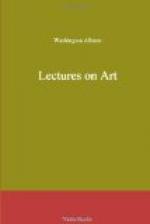We are now brought to the important question, Where and what is this reconciling ground? Certainly not in sensation, for that could only reflect their distinctive differences. Neither can it be in the reflective faculties, since the effect in question, being co-instantaneous, is wholly independent of any process of reasoning; for we do not feel it because we understand, but only because we are conscious of its presence. Nay, it is because we neither do nor can understand it, being therefore a matter aloof from all the powers of reasoning, that its character is such as has been asserted, and, as such, universal.
Where, then, shall we search for this mysterious ground but in the mind, since only there, as before observed, is this common effect known as a fact? and where in the mind but in some inherent Principle, which is both intuitive and universal, since, in a greater or less degree, all men feel it without knowing why?
But since an inward Principle can, of necessity, have only a potential existence, until called into action by some outward object, it is also clear that any similar effect, which shall then be recognized through it, from any number of differing and distinct objects, can only arise from some mutual relation between a something in the objects and in the Principle supposed, as their joint result and proper product.
And, since it would appear that we cannot avoid the admission of some such Principle, having a reciprocal relation to certain outward objects, to account for these kindred emotions from so many distinct and heterogeneous sources, it remains only that we give it a name; which has already been anticipated in the term Harmony.
The next question here is, In what consists this peculiar relation? We have seen that it cannot be in any thing that is essential to any condition of mere being or existence; it must therefore consist in some undiscoverable condition indifferently applicable to the Physical, Intellectual, and Moral, yet only applicable in each to certain kinds.
And this is all that we do or can know of it. But of this we may be as certain as that we live and breathe.
It is true that, for particular purposes, we may analyze certain combinations of sounds and colors and forms, so as to ascertain their relative quantities or collocation; and these facts (of which we shall hereafter have occasion to speak) may be of importance both in Art and Science. Still, when thus obtained, they will be no more than mere facts, on which we can predicate nothing but that, when they are imitated,—that is, when similar combinations of quantities, &c., are repeated in a work of art,—they will produce the same effect. But why they should is a mystery which the reflective faculties do not solve; and never can, because it refers to a living Power that is above the understanding. In the human figure, for instance, we can give no reason why eight




